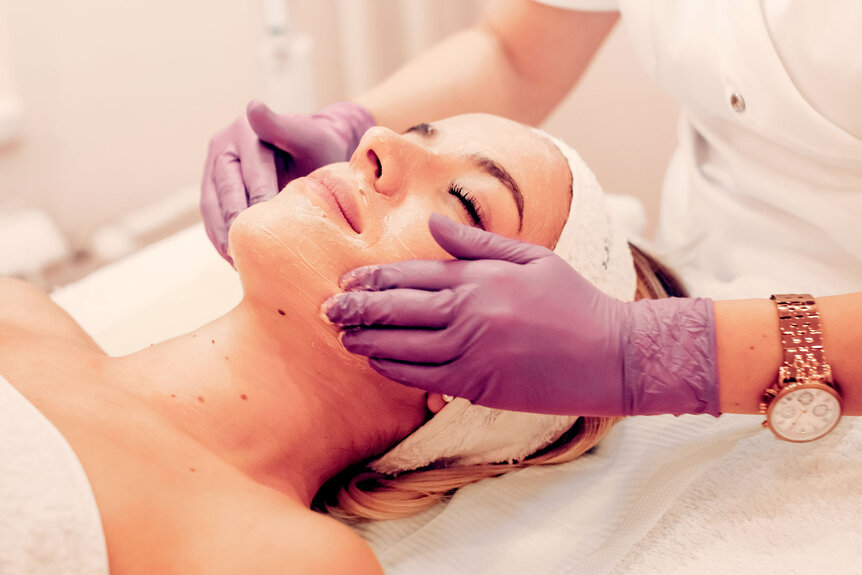The Real Housewives LOVE Their Chemical Peels: Here's What You Need to Know
We turned to dermatologists for answers to all the questions you're afraid to ask.

If you’ve been afraid of chemical peels for most of your life, there’s really no way we could blame you. The treatment combines two of the scariest words possible when it comes to skincare (chemical and peel? Yikes!), and we’ve seen some pretty gnarly examples of chemical peels gone wrong.
For instance, there was that time when The Real Housewives of New Jersey’s Melissa Gorga was enjoying time in the outdoors following her own chemical peel, and, well, it did not end well. Oh, and let’s not forget in Season 9 of The Real Housewives of New York City when Ramona Singer was just trying to have a good time in Mexico while dealing with her own post-chemical peel mishap — except as Sonja Morgan put it, “her face is like a pizza pie with no cheese.” (Relive that incredible RHONY moment by pressing play on the video above.)
The thing is, chemical peels don’t always make your face look red and raw. Some are so mild that you can barely tell you’ve had one, and many simply leave your skin radiant and glowing. The more aggressive types of chemical peels do require some downtime and post-treatment care, but following proper protocol (like staying out of the sun) can prevent your skin from straying into cheese-less pizza territory.
With expert help, we’ve done some myth busting below.
Myth: All Chemical Peels Are the Same
There’s an entire spectrum of chemical peels out there. Some target the superficial layers of skin (these are the mildest), while some go into the medium and then deep layers of the skin. The deeper the peel, the more side effects you’ll see.
“There are so many incredible acids out there that can treat the unique needs of each person’s skin type,” celebrity esthetician Karee Hays told The Lookbook. Her clientele includes Faith Hill, Lily Aldridge, and Kristin Cavallari.
“Chemical peels can range from a gentle fruit acid peel that may only cause a slight sense of dryness or delicate sloughing of the skin (these are brightening peels like glycolic and mandelic that really work on the surface of the skin) to the more aggressive peel concoctions [like TCA peels] that penetrate into the deeper layers of the epidermis to stimulate cell turnover and can cause some significant peeling. These [more aggressive] peels really work on texture issues and pigmentation.”
Compare it to walking into the hair salon to get your hair cut and colored. Not everyone walks out with the same exact style because the treatment is tailored specifically to the client’s needs and wants. The same is true for chemical peels.
Myth: Chemical Peels Always Sting
It’s true that chemical peels are associated with a tingly or stinging sensation. However, if you’re using a very mild peel (like an at-home glycolic acid, for example), then it’s possible that you won’t feel much at all. The deeper, more aggressive peels are more likely to sting.
Myth: You’ll Definitely Have a Red Face After a Chemical Peel
Redness usually coincides with the amount of stinging you’ll experience. The more aggressive the peel, the more red or raw your skin will be afterward. On the contrary, if you’re using a very mild peel, chances are you won’t see much redness at all. Also, how much tingling or redness you experience depends on how familiar your skin is with peels.
“The skin on a client who has been using great medical-grade skincare for a few months is likely to respond more favorably to a peel and potentially have a shorter downtime, where more sensitive skin that has never been exposed to medical-grade acids will need to be babied a bit more through the process,” Hayes noted.
Myth: Your Skin Will Melt Off After a Chemical Peel
Some peeling is expected after a chemical peel. The deeper the treatment, the more peeling you’ll experience and vice versa. This ranges from virtually zero peeling, to very mild “pencil eraser” bits that show up a few days later, to very noticeable, non-stop peeling that lasts for several days. That said… your face isn’t going to melt off. However, if you’ve learned anything from Melissa Gorga, you do need to be more mindful of your time spent in the sun.
“Since you’re taking off the top layer of skin, you have to be careful with the sun because it can affect how your skin heels,” Dr. Shari Sperling, a board-certified dermatologist based in New Jersey, said. “If you’re peeling, excessive sun exposure could potentially lead to scarring and pigmentation issues. [This is true] with any damage or trauma to the skin.”
You’ll definitely want to limit your exposure to the sun following a deep peel in order to expedite healing and prevent any sun damage. Wear large hats, stay in the shade, and slather on SPF religiously. You’ll also want to treat your skin with more care. Use hydrating cleansers, moisturize often, and be gentle. If your skin does peel, let it roll off naturally in the shower or while cleansing. Peeling it off yourself can damage your skin and case pain.
Myth: You Can Only Get Chemical Peels at the Salon
Medium to aggressive peels that affect the deep layers of skin — such as the VI peel, Perfect Derma Peel, and TCA peel — are administered by a professional in a salon. There’s also an entire market of chemical peels you can buy for at-home use. These come in multiple forms, including pads, serums, masks, and liquids, and vary in aggressiveness. The majority are very mild, though you do need to be mindful of instructions.
Savor Beauty’s Pumpkin Enzyme Peel ($80) combines lactic and gluconic acids to tone, clarify, soften, and increase collagen production and cell turnover. It feels lightly tingly on your skin, but will leave your face radiant. For a milder option, try Drunk Elephant’s T.L.C. Framboos™ Glycolic Night Serum ($90). It contains raspberry fruit extracts to re-hydrate and soothe, salicylic acid to clarify, and a 12 percent AHA blend to resurface.
Myth: One Chemical Peel is Enough for a Lifetime
As with anything in skincare, consistent upkeep is key. Deep, medical-grade peels (such as TCA) are often done at a frequency of once a year, while medium peels can be done once every few months. Very mild peels, such as those used at home, can be applied a few times a week and are perfect for upkeep between professional peels.
“Consistent, light peels keep the skin glowing,” Hayes explained. “Fresh, healthy skin cells reflect light, and a light peel gently exfoliates dead skin away without the down time of a more aggressive professional peel. They help with dryness and keep the skin from feeling dull. They also help your products absorb better.”
Ease into these lighter peels to get a feel for them and to acclimate your skin. From there, you can graduate to the more aggressive options. Just remember that it’s a very tailored process, so speak with your dermatologist or esthetician about what’s best for you.








